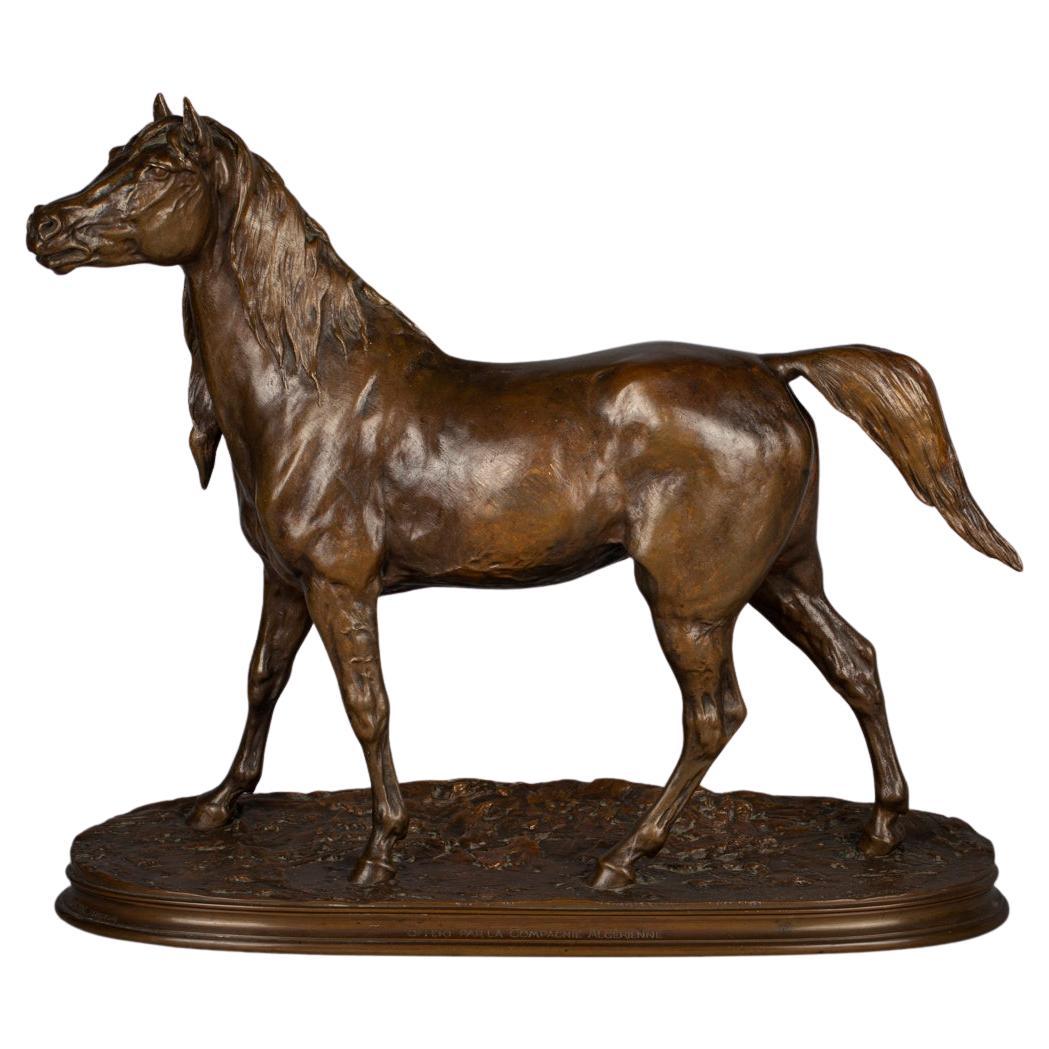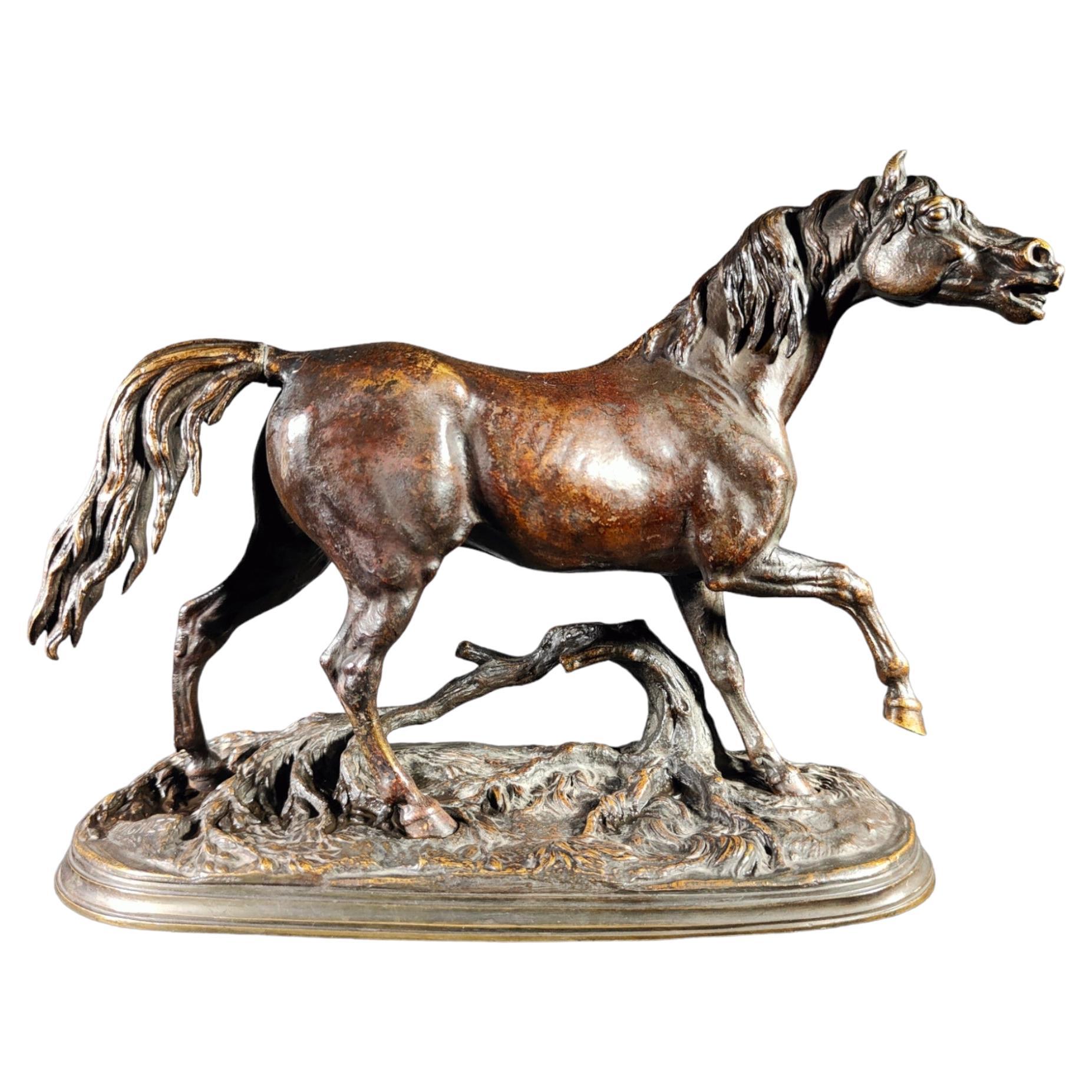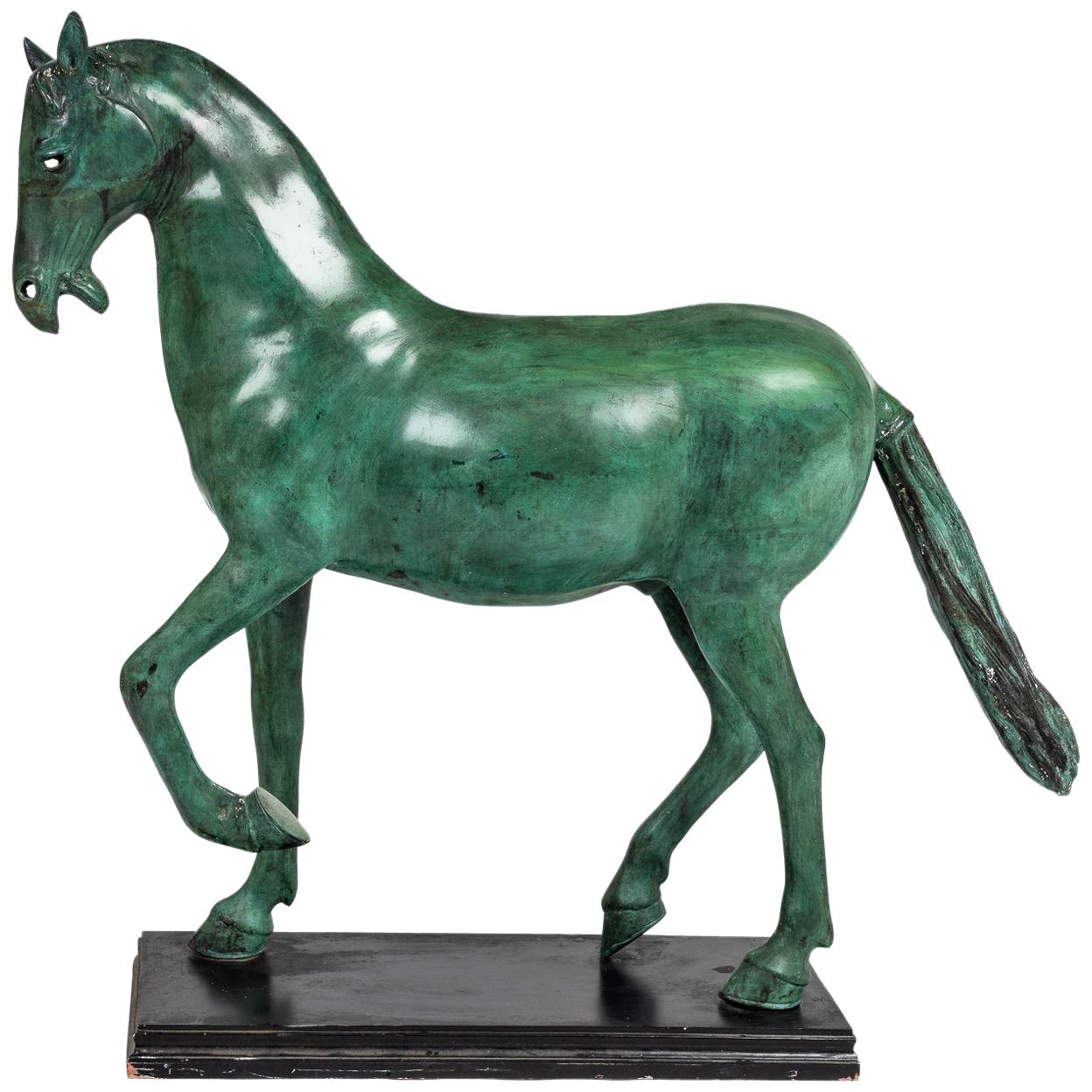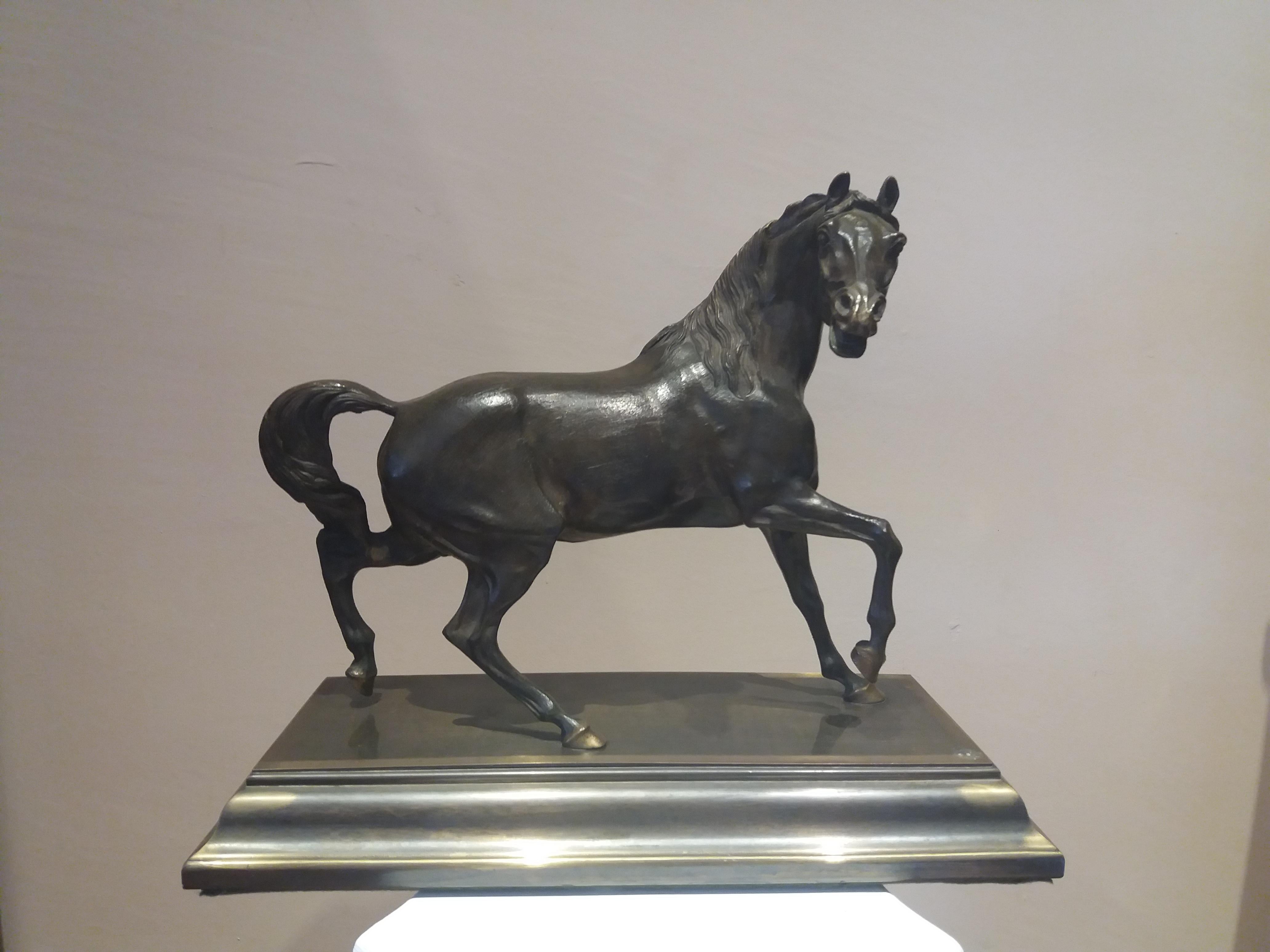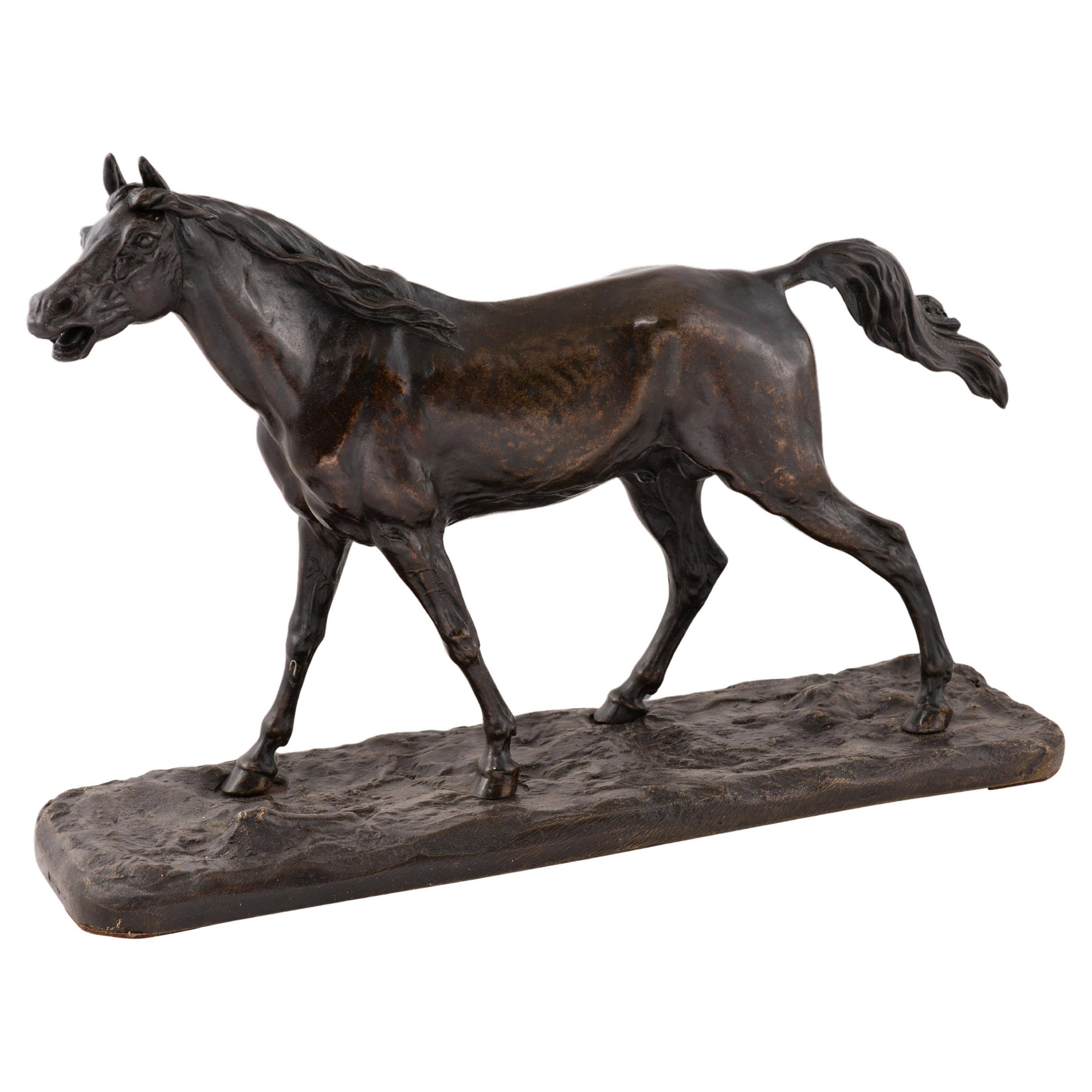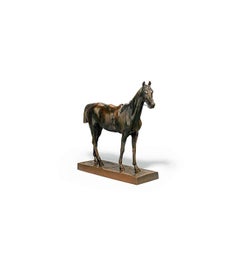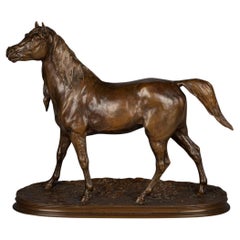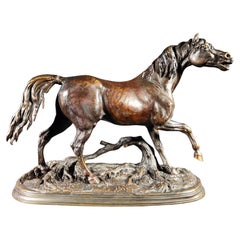Items Similar to Mare - hunting horse by Josuë Dupon 1864-1935
Want more images or videos?
Request additional images or videos from the seller
1 of 10
Josuë DuponMare - hunting horse by Josuë Dupon 1864-1935
$15,060
£11,648.29
€13,260.91
CA$21,623.73
A$23,624.59
CHF 12,381.73
MX$282,085.12
NOK 156,691.95
SEK 146,111.99
DKK 99,037.80
About the Item
A beautiful large bronze sculpture of a proud standing mare. Old sand cast created during the artist Josuë Dupon's lifetime.
Josuë Dupon (also Josué or Josue Dupon) was a Flemish sculptor and engraver. His work also includes painting and graphics.
He received his training through evening classes at the academy of Roeselare and Antwerp (1884) and later at the National Institute of Fine Arts (1887). In 1891, he won a gold medal with the monumental sculpture group Samson kills the lion and was runner-up in the Prix de Rome for sculpture. From that year on, his work appeared regularly in exhibitions at home and abroad. His reputation was such, that he became one of a select group of sculptors allowed by King Leopold II to carve statues in Ivory, which was imported from the Congo, the Belgian colony. In 1893 his exceptionally refined ivory statue of Diana was bought by the Antwerp Royal Museum of Fine Arts, which also acquired his spectacular bronze Vulture defending its prey a year later.
Working in every genre and mastering every technique and material, Josuë Dupon became best known as a sculptor of exotic animals. He was equally capable of faithfully expressing anatomical detail as of rendering the animals' nature. Josuë Dupon was a technically faultless realist, with a sense of the dramatic, a feeling for decorative complexity and a tendency towards idealizing. The placement of his camel driver and two bronze groups at the entrance to Antwerp Zoo confirmed this reputation as animalier.
The career that Dupon subsequently built, brought him numerous important awards and an appointment as professor at the Antwerp Academy, a tenure he held between 1905 and 1934. Besides animals, he sculpted busts, war memorials and public monuments. For one of the largest sculptural monuments and the largest fountain in the city of Buenos Aires, called Monument of the Two Congresses, he collaborated with his good friend, the Belgian sculptor Jules Lagae. Josuë Dupon created several statues of mighty condors for this monument.
At the start of his career his conception of art was strongly influenced by traditional 19th century artistic ideals. After the turn of the century his compositions and surface treatment changed and became more modern. He met Rembrandt Bugatti around 1905 or 1906 in the 'Jardin des Plantes' in Paris and invited him to Antwerp. Bugatti began travelling to Antwerp in 1906 to observe and sculpt the inhabitants of its zoo, which was then considered the best in the world, and Dupon allowed Bugatti to stay with him during several of his early visits. As such Dupon became a friend and a bit of a father figure to Rembrandt Bugatti.
Dupon did not play a very active part in artistic movements or associations. Dupon remains an important sculptor not only through his body of work but also because of the influence he exercised through interactions and collaboration with other sculptors such as Lagae, Bugatti and Bourdelle but also because he trained leading sculptors such as Albéric Collin (1886-1962), Willy Kreitz (1903-1982) and Albert Poels (1903-1984).
- Creator:Josuë Dupon
- Dimensions:Height: 20.48 in (52 cm)Width: 19.69 in (50 cm)Depth: 5.91 in (15 cm)
- Medium:
- Period:
- Condition:
- Gallery Location:Gent, BE
- Reference Number:1stDibs: LU2140213716232
About the Seller
5.0
Vetted Professional Seller
Every seller passes strict standards for authenticity and reliability
Established in 2018
1stDibs seller since 2022
6 sales on 1stDibs
Typical response time: 6 hours
- ShippingRetrieving quote...Shipping from: Gent, Belgium
- Return Policy
More From This Seller
View AllLouis Alfred Joseph CUVELIER, Bronze + Stationary racehorse
Located in Gent, VOV
Stationary racehorse.
This exceptional bronze sculpture by Louis Alfred Joseph Cuvelier depicts a racehorse in mid-stride, captured in a moment of intense energy and motion. Cast by...
Category
19th Century Realist Figurative Sculptures
Materials
Bronze
P.J. Mene 1846, Bronze cast+ Djinn, Arabian Stallion
Located in Gent, VOV
Djinn, Arabian stallion 1846
A French bronze horse with a dark patina with brown undertones entitled 'Djinn étalon arabe' cast from the model by Pierre-Jules Mène (1810-1879), secon...
Category
Mid-19th Century French School Figurative Sculptures
Materials
Bronze
Vimar Auguste (1851-1916)+bronze, Bohemian horse and monkeys
Located in Gent, VOV
Bohemian horse and monkeys
As early as 1900, Vimar started to create sculptures. His reputation as an illustrator and painter was at its peak.His sculp...
Category
Late 19th Century Naturalistic Figurative Sculptures
Materials
Bronze
bronze horse statue by Patrick Villas
By Patrick Villas
Located in Gent, VOV
Standing horse sculpture in bronze 2001.
The first cast of a proud standing horse, looking to the side. A fine bronze statue by Patrick Villas (°1961), in his typical expressionist ...
Category
21st Century and Contemporary Expressionist Figurative Sculptures
Materials
Bronze
Bronze Draught Horses Sculpture By Hager Albert (1857-1940)
By Albert Hager
Located in Gent, VOV
Two draught horses, 1925
A fine bronze sculpture with dark brown patina with a reddish undertone., representing two draught horses one grazing, one looking forward. Documented in En...
Category
Early 20th Century Realist Figurative Sculptures
Materials
Bronze
Edgar Degas (1834 – 1917), Bronze cast +« Cheval marchant au pas relevé »
By Edgar Degas
Located in Gent, VOV
« Cheval marchant au pas relevé » (Horse walking at a high pace)
Bronze with dark brown patina bearing the stamp of the signature "Degas", numbered IV/IX and dated 1998. Posthumous lost wax casting as of 1998. Stamp of Valsuani.
The work is a sought-after rarity in terms of Degas’ sculptures. This bronze is distinguished by the fact that it is a Valsuani bronze, meaning it faithfully records Degas’ wax version’s as it appeared at the time of its creation. Most Degas' bronzes that are found on the market were cast by Hébrard – these serialized bronzes are surmoulages, or “aftercasts,” that were cast from the modèle bronzes currently in the Norton Simon Museum (Pasadena). Because these bronzes are second generation, they are smaller and far less detailed than the current bronze.
This example, however, was cast by Valsuani from a plaster that was taken directly from Degas’ waxes, according to scholarship by the art historian Dr. Gregory Hedberg. These plasters were created by Degas’ sculptor friend Albert Bartholomé shortly after Degas completed his wax figurines. Thus, they record the earliest versions of Degas’ wax sculptures, before they were damaged by time or handling, and before Degas himself altered the works. The Hébrard bronzes...
Category
Late 20th Century Impressionist Figurative Sculptures
Materials
Bronze
You May Also Like
French Bronze Sculpture of a Stallion, PJ Mene (1810-1871)
Located in New York, NY
This highly detailed study of a Normandy mare is an excerpted model from Mêne's popular Jument normande et son poulain, exhibited in wax at the 1868 Salon (no. 3749), and in bronze t...
Category
Antique 1850s French Animal Sculptures
Materials
Bronze
$18,000 Sale Price
20% Off
Antique Horse Bronze Trotting Stallion Isidore Jules Bonheur (France, 1827-1901)
By Isidore Jules Bonheur
Located in SANTA FE, NM
Antique Horse Bronze
Portrait of a Trotting Stallion
Isidore Jules Bonheur (France, 1827-1901)
Cast bronze mounted on a rectangular plinth with dark brown patina,
Signed: I. BONHEUR
17 x 11 3/4
A brilliant exploration of a stallion in full trot. The patina is a deep, warm walnut brown with honey-colored tones.
Isidore Bonheur was best known and the most distinguished of the 19th century French animalier sculptors. Isidore, the younger brother of Rosa Bonheur and older brother of Auguste, began his studies of painting initially with his father, who was friends with Francisco Goya. By 1848 he debuted at the Paris Salon having discontinued animal and landscape painting to concentrate on creating sculptures and in 1849, Bonheur enrolled at the Ecole des Beaux Arts. He won medals at the Paris Salon in 1859 and did so again in 1865 and in 1869. After entering the Exposition Universelle 1855, he won the Gold Medal in 1889. In the 1870s exhibited in the London at the Royal Academy of Arts where he earned great prestige and won the coveted Medaille d’Or. After winning numerous other medals and prizes, Bonheur was awarded the Legion d' Honneur in 1895 and he was Knighted in Portugal, Spain and France. Bonheur continued exhibiting at the Paris Salon until 1899.
Many of his bronzes were fabricated at the foundry owned by Hippolyte Peyrol, Bonheur's brother-in-law by marriage to Isidore’s youngest sister Juliette Bonheur. The Peyrol casts for both Rosa and Isidore are exceptionally well executed which suggests a strong working relationship between the founder and sculptor. There is little doubt that Isidore Bonheur was an acute observer of nature; his animals were not anthropomorphized but modelled to catch movement or posture characteristics of the particular species he was sculpting. He achieved this most successfully with his sculptures of horses which are usually depicted as relaxed rather than spirited. These figures are among his most renowned works and his equestrian models became very popular, particularly among the British aristocracy.
An acute observer of nature, his sculptures reflect his commitment to the Realist school - with precise detailing of the movements of animals in their natural habitats. Ultimately, His naturalistic studies of animals are now some of the most highly sought after works by any of the animalier. He was possibly inspired by his many visits to the Buffalo Bill Wild West Show...
Category
1870s Realist Figurative Sculptures
Materials
Bronze
Jules Moigniez Bronze Horse
Located in Madrid, ES
Jules Moigniez (1835-1894) bronze horse
Very pretty bronze horse signed by J Moigniez from the XIX century. It has a very nice patina that it has ...
Category
Antique 1860s Figurative Sculptures
Materials
Bronze
Large Bronze Horse
Located in Munich, Bavaria
Large Bronze Standing Horse Sculpture with Green Patina
Magnificent handcrafted bronze sculpture of a standing horse with fine detailing and a beautiful ...
Category
20th Century Unknown Arts and Crafts Animal Sculptures
Materials
Bronze
$6,096 Sale Price
20% Off
horse. 19th century bronze sculpture
Located in CORAL GABLES - MIAMI, FL
horse. 19th century bronze sculpture
measurements with the base are 37.5 x 17.5 x 31 cm
Category
Late 19th Century Art Nouveau Figurative Sculptures
Materials
Bronze
Horse. Patinated metal. 19th century.
Located in Madrid, ES
Horse. Patinated metal. 19th century.
Figure of a walking horse with a bronze base and a patinated iron animal. It shows a strong influence from the animal figures common in the 19...
Category
Antique 19th Century French Neoclassical Revival Figurative Sculptures
Materials
Bronze, Iron
$638 / set
